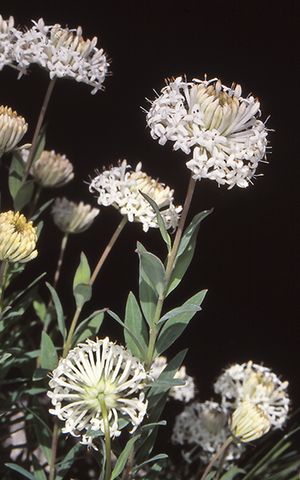Grey rice-flower facts for kids
Quick facts for kids Grey rice flower |
|
|---|---|
 |
|
| Scientific classification | |
| Genus: |
Pimelea
|
| Species: |
treyvaudii
|
The Pimelea treyvaudii, also known as the grey rice-flower, is a type of shrub in the Thymelaeaceae plant family. It has pretty white flowers that grow in round clusters at the end of its branches. This plant is special because it is only found in eastern Australia.
What it Looks Like
The grey rice-flower is a small shrub, usually growing about 20 to 30 centimeters (about 8 to 12 inches) tall. Its stems are smooth. The leaves grow in pairs opposite each other. They are long and narrow, measuring about 6 to 37 millimeters (about 0.2 to 1.5 inches) long and 1 to 10 millimeters (about 0.04 to 0.4 inches) wide. They are a uniform grey color, sometimes a bit lighter underneath.
The flowers grow in a round, ball-shaped cluster. Around the flowers are 9 to 11 special leaves called bracts. These bracts are narrow and egg-shaped, about 6 to 15 millimeters long. They are smooth on the outside and a bit hairy on the inside. They are creamy at the bottom and green towards the top, sometimes with a purplish color.
The white flowers have both male and female parts. They are shaped like a tube, about 10 to 12 millimeters long, and are smooth inside with long hairs pointing upwards. The small, leaf-like parts that protect the flower bud, called sepals, are about 3 to 5 millimeters long. The tiny stalks that hold each flower are hairy. The male parts of the flower, called stamens, can be either longer or shorter than the sepals.
After flowering, the plant produces small, dry fruits that are covered in fine hairs. These fruits form a dense, cone-shaped cluster. You can see the grey rice-flower blooming from May all the way through to February.
How it Got Its Name
The grey rice-flower, Pimelea treyvaudii, was officially described in 1912. Two scientists, Alfred James Ewart and Bertha Rees, published its description in a scientific paper called Proceedings of the Royal Society of Victoria. They used notes from an earlier, unpublished description by another famous botanist, Ferdinand von Mueller. The first plant samples used to describe this species were collected near a place called Cudgewa by H.H. Treyvaud, which is why the plant was named treyvaudii after him.
Where it Lives
The grey rice-flower grows in different parts of eastern Australia. You can find it from Gowan in New South Wales, stretching south-east into north-eastern Victoria. It often grows in woodlands and sometimes on dry, rocky hillsides in mountainous areas.

